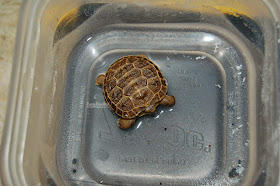Ok, today I want to share with you the somewhat scary beginning of our Russian tortoise Hatchling#3. I wanted to wait to be sure there was a happy ending. Rest assured, all is well now!
 |
| Baby#3, healthy and chipper now |
First, I want to thank my very knowledgeable friend Melissa, who helped me and advised and encouraged me... at 10pm! She deserves a huge hug. I am so thankful she is a part of my life!
I wanted to share this, first because I think it's just amazing how nature is set up, and second, because I am amazed at how robust these wee babies actually are, given the proper care.
First, here is a picture of a normal hatchling's cute fat little belly a few hours after hatching. It is normal for baby tortoises to hatch with a small yolk sac still hanging out of their belly button. This then absorbs within a few days, and baby can go its merry way.
 |
| A normal hatchling's fat little belly. This is Baby#2. |
Well, when I saw Baby#3 was pipping, I moved the egg to the container in the incubator with a moist paper towel. I did this because I was going to be busy, and didn't want baby to hatch onto the incubation substrate and possibly ingest some or get some stuck on its belly. In retrospect, I am so glad I did this!
I checked on it sequentially, and saw first a little head and leg... and then I checked back in a few hours later, and saw baby RT#3 out of the egg, but with a big orange thing under its belly. Yikes!
 |
| This is not what you want to see... a huge yolk sac! |
I carefully took the baby out to investigate, and oh dear, it looked terrible! The yolk sac was huge, and there was some kind of pink thing on the end of it!
 |
| The yolk sac is way too big on this wee tortoise - she's a preemie! |
I contacted my friend Melissa (who knows a lot more about tortoises and breeding than I do), and she assured me that this happens, and that it will probably absorb, with proper care. Baby should have probably stayed in the egg for a few more days, but might have kicked a hole in the egg while turning, which resulted in a premature hatch.
I made a little donut pillow out of a moist paper towel, and put baby on it, with the yolk sac in the middle. This way the baby's body weight wouldn't be squishing the sac. The moisture protected the membranes.
 |
| Baby#3 on her donut pillow |
I then covered baby with a second moist paper towel, since babies like to feel covered. I closed the incubator, said a silent prayer, and went to bed. I knew the best thing for baby was to be left alone now.
 |
| Night night wee baby! |
The next morning I shone a light into the incubator, but didn't open it. Baby was still on its donut pillow, but it moved a leg and opened its eyes when I shone the light in. It was alive!
Towards late afternoon, I checked again, and baby had moved off of its little donut. I decided now was a good time to check on baby - and was amazed to see that most of the yolk sac really had absorbed.
 |
| Still not perfect, but SO much better! |
I soaked baby in some warm water, and placed it back in the incubator in the container with moist towels. She was chipper, and walked around, even climbed up and over her little donut, which she no longer needed.
 |
| Soaking in warm water helps keep baby hydrated, and helps keep the tissue soft as it heals |
Over the following days I continued to just leave her alone, except to soak her for 20mins each day. The yolk sac continued to absorb. The following pic is about 36 hours after hatching.
 |
| Much better - still just a little bit of healing necessary! |
Here is Baby#3, when I was confident she would be OK!
 |
| No longer in danger, WHEW! |
Now the yolk sac is fully absorbed, and the little umbilical wound is almost completely closed. The little pink 'tag' has gone inside now, too. She is going to be just fine.
 |
| In another day or so, her little plastron will look completely normal |
Also, interesting fact: She flipped herself back onto her belly all by herself right after I took this picture.
Welcome to the world, little RT Baby#3!
 |
| She has the cutest face! |
...watch out, she'll charm the socks off of you!
Ps: I refer to this baby as 'she' and 'her' based on the fact that the incubation temperatures were high. Tortoises can be temperature sexed, with higher temperatures resulting in females, lower temperatures resulting in males. There is no guarantee, but it is VERY LIKELY that this is a female.












OMG these pics are adorable! I loved reading the story & I'm elated she's ok.
ReplyDeleteOh so glad Baby #3 is looking good. I have mothered hatchling eastern box turtles in my backyard for 20+ years and have had a few yolk sacs like these and all have somehow survived and eventually thrived. With the yolk sac, they don't need to eat for a while, sometimes weeks for my boxies. My most recent one (from about 15 earlier ones) refused all worms and would only nibble canned greenbeans. Your Russian torties are amazingly beautiful. Looks well adjusted and ready for a cozy!
ReplyDelete